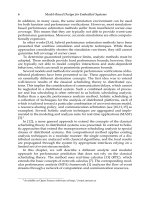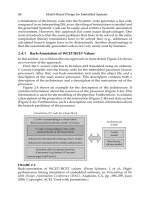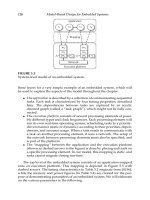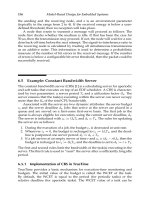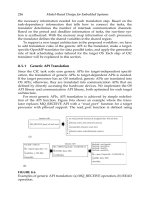Model-Based Design for Embedded Systems- P57 doc
Bạn đang xem bản rút gọn của tài liệu. Xem và tải ngay bản đầy đủ của tài liệu tại đây (402.81 KB, 10 trang )
Nicolescu/Model-Based Design for Embedded Systems 67842_C016 Finals Page 546 2009-10-2
546 Model-Based Design for Embedded Systems
implicitly the synchronization. This property verifies that after a cycle exe-
cuted by each model, both are at the same time stamp (and by consequence
are synchronized)
Definition: Invariantly both processes in the Start location (initial state)
imply the time in the continuous domain t
c
isequalwiththetimeinthe
discrete domain t
d
.
P4 Causality principle (liveness property)
The causality can be defined as a cause andeffectrelationship. The causal-
ity of two events describes to what extent one event is caused by the other.
The causality is already verified by P3 for scheduled events. However, when
a state event is generated by the continuous domain, the discrete domain has
to detect this event at the same precise time (the cause precedes or equals the
effect time) and not some other possible event existing at a different time in
the continuous domain.
Definition: Invariantly both processes in the StEvDetect location
(detection of state event) imply the time in the continuous t
c
is equal with
thetimeinthediscretet
d
.
16.6.6 Definition of the Internal Architecture of the
Simulation Interfaces
The overall continuous/discrete simulation interface is formally defined
using the DEVS formalism. As shown in Figure 16.4, the interface is
described as a set of coupled models: the continuous domain interface
(CDI), the discrete domain interface (DDI), and the co-simulation bus.
Figure 16.12 shows the atomic modules composing the interface used in our
implementation.
The specific functionalities of the interfaces were presented in Sec-
tion 16.4.2. In terms of internal architecture, the blocks assuring these fea-
tures are
For the Continuous Model Simulation Interface
• The State Event Indication and Time Sending block (SETS)
• The Signal Conversion and Data Exchange block (SCDE)
• The Event Detection block (DED)
• The Context Switch block (CS)
For the Discrete Model Simulation Interface
• The End of Discrete Simulation Cycle Detection and Time Sending block
(DDTS)
• The Data Exchange block (DE)
• The Event Detection block (DEC)
• The Context Switch block (CS)
These atomic modules are forming the co-simulation library and the co-
simulation tools enable their parameterization and their assembly in order
to generate a new co-simulation instance.
Nicolescu/Model-Based Design for Embedded Systems 67842_C016 Finals Page 547 2009-10-2
Generic Methodology for the Design 547
Continuous/discrete
global simulation model
Continuous/discrete
simulation interface
Continuous domain
simulation interface-CDI
Continuous
model
Discrete
model
Data
exchange
DE
Context
switch CS
Co-simulation
bus
Elements from the co-simulation library
Signal
conversion and
data exchange
SCDE
Context
switch
CS
State event
indication and time
sending SETS
Event
detection DED
End of discrete simulation
cycle detection and
time sending
DDTS
Event
detection DEC
Discrete model simulation
interface-DDI
FIGURE 16.12
The hierarchical representation of the generic architecture of the co-
simulation model with the elements of the co-simulation library defined.
(From Gheorghe, L. et al., Formal definition of simulation interfaces in a
continuous/discrete co-simulation tool, Proceedings of the 17th IEEE Inter-
national Workshop on RSP, Chania, Crete, Greece, pp. 186–192, 2006. With
permission.)
End of discrete
simulation cycle
detection and
time sending
DDTS
Discrete domain interface DDI Continuous domain interface CDI
Discrete/continuous
data exchange
Flag from the discrete to the continuous model
Flag from the continuous to the discrete model
Time of state event tse
Time of the next scheduled event in the discrete simulator td
State event
indication
and time
sending SETS
Data
exchange
DE
Context
switch
CS
Context
switch
CS
Event
detection
DEC
Event
detection
DED
Signal
conversion
and data
exchange
SCDE
Data to/from the discrete
simulator DS
Data to/from the continuous
simulator DS
FIGURE 16.13
Internal architecture of the continuous/discrete simulation interface. (From
Gheorghe, L. et al., Formal definition of simulation interfaces in a
continuous/discrete co-simulation tool, Proceedings of the 17th IEEE Inter-
national Workshop on RSP, Chania, Crete, Greece, pp. 186–192, 2006. With
permission.)
Figure 16.13 presents the atomic modules interconnection in each domain
specific simulation interface as well as the signals and interactions between
the interfaces.
Nicolescu/Model-Based Design for Embedded Systems 67842_C016 Finals Page 548 2009-10-2
548 Model-Based Design for Embedded Systems
The internal architecture is defined as a set of coupled modules that
respect the coupled modules DEVS formalism as presented in Section 16.6.1:
-N
interface
=(X,Y, D,{M
d
|d ∈ D}, EIC,EOC,IC )
-X ={(p
d
, v
d
)|p
d
∈ InPorts, v
d
∈ Xp
d
}
-Y ={(p
d
, v
d
)|p
d
∈ OutPorts, v
d
∈ Yp
d
}
-Xp
d,
Yp
d
= values for input ports, respectively output ports
-InPorts =P
in,c
∪P
in,d
∪P
in,td
∪P
in,tse
∪P
in,flag
where
P
in,c
– set of ports receiving data from the continuous model; P
in,d
–set
of ports receiving data from the discrete model (via the co-simulation
bus);
P
td
– port receiving the timestamp of the next discrete event
P
in,flag
– port receiving the command for the context switch
- OutPorts =P
out,c
∪P
out,d
∪P
out,td
∪P
out,tse
∪P
out,flag
P
out,flag,
P
out,c
,P
out,d
are defined similarly to P
in,flag,,
P
in,c
and P
in,d
- D = {“Continuous Domain Interface” (with associated model
N
interfaceCDI
), “Discrete Domain Interface” (with associated model
N
interfaceDDI
), “co-simulation bus” (with associated model M
cosim
)}
−M
d
= (N
interfaceCDI
, M
interfaceDDI
, M
cosim
)
−EIC ={((N
interface
,“in
c,1
), (N
interfaceCDI
,“in
c,1
)); ;
((N
interface
,“in
c,n
), (N
interfaceCDI
,“in
c,n
));
((N
interface
,“in
d,0
), (N
interfaceDDI
,“in
d,0
)); ;
((N
interface
,“in
d,m
), (N
interfaceDDI
,“in
d,m
))}
−EOC ={((N
interfaceCDI
, “out
c,1
), (N
interface
,“out
c,1
)); ;
((N
interfaceCDI
, “out
c,p
), (N
interface
, “out
c,p
));
((N
interfaceDDI
, “out
d,1
), (N
interface
, “out
d,1
)); ;
((N
interfaceDDI
, “out
d,q
), (N
interface
, “out
d,q
))}
−IC ={((N
interfaceCDI
, op
CDI
), (M
cosim
, ip
cosim
))|N
interfaceCDI
,
−M
cosim
∈ D, op
CDI
∈ OutPorts
CDI,
ip
cosim
∈ InPorts
cosim
}∪
{((N
interfaceDDI
, op
DDI
), (M
cosim
, ip
cosim
))|N
interfaceDDI
,
M
cosim
∈ D, op
DDI
∈ OutPorts
DDI,
ip
cosim
∈ InPorts
cosim
}∪
{((M
cosim
, op
cosim
), (N
interfaceCDI
, ip
CDI
))|N
interfaceCDI
,
M
cosim
∈ D, op
cosim
∈ OutPorts
cosim,
ip
CDI
∈ InPorts
CDI,
}∪
{((M
cosim
, op
cosim
), (N
interfaceDDI
, ip
DDI
))|N
interfaceDDI
,
−M
cosim
∈ D, op
cosim
∈ OutPorts
cosim,
ip
DDI
∈ InPorts
DDI,
}[12]
We show here the atomic module co-simulation bus that can be formally
defined as follows:
- X. ={(p
d
, v
d
) |p
d
∈InPorts, v
d
∈Xp
d
}
- Y ={(p
d
, v
d
) |p
d
∈OutPorts, v
d
∈Yp
d
}
Nicolescu/Model-Based Design for Embedded Systems 67842_C016 Finals Page 549 2009-10-2
Generic Methodology for the Design 549
- InPorts = P
in,c
∪P
in,d
∪P
in,td
∪rmP
in,tse
∪P
in,flag
- OutPorts = P
out,c
∪P
out,d
∪P
out,td
∪P
out,tse
∪P
out,flag
where P
in,c
,P
in,d
P
in,td
,P
in,tse
,P
in,flag
P
out,c
,P
out,d
,P
out,td
,P
out,tse,
P
out,flag
as well as Xp
d
, Yp
d
were previously defined.
States triplet S: (phase * σ * job) where:
phase: (“passive,” “active”)
σ :
+
0
advance time
job: (“store,” “respond”)
S ={“passive,” “active”} *
+
0
* {“store”, “respond”}
δ
ext
((“passive” * σ * job), e, x))=
(“passive,” σ –e, x), if x =0
(“active”, σ –e, job), if x! =0
δ
int
(s) =(“active”, σ,job)
λ (“active,” σ,job)={“store”, “respond” }
t
a
(phase, σ,job)=σ
The architecture of the discrete domain interface and the continuous
domain interface are also formally defined as a set of coupled modules. For-
mal descriptions for DDI and CDI respect the coupled module DEVS formal-
ism. Each element of the structure follows the concepts presented in Section
16.6.1 and that were applied for the overall continuous/discrete simulation
interface.
16.6.7 Analysis of the Simulation Tools for the Integration
in the Co-Simulation Framework
The previous steps that describe the gradual formal definition of the simu-
lation interfaces and the required library elements are independent of the
different simulation tools and specification languages used generally for
the specification/execution of the continuous and discrete subsystems. After
the analysis of the existing tools we found that Simulink is an illustra-
tive example of a continuous simulator enabling the control functionalities
that were presented in Section 16.4.5. These functionalities can be added in
generic library blocks and a given Simulink model may be prepared for the
co-simulation by parameterization and addition of these blocks.
Several discrete simulators present the characteristics detailed in Section
16.4.5. SystemC is an illustrative example. Since it is an open source, SystemC
enables the addition of the presented functionalities in an efficient way—the
scheduler can be modified and adapted for co-simulation. In this way, the co-
simulation overhead may be minimized. However, the addition of simula-
tion interfaces is more difficult than in Simulink because the specifications in
SystemC are textual and a code generator is required to facilitate the addition
of simulation interfaces. The automatic generation of the co-simulation inter-
faces is very suitable, since their design is time consuming and an important
source of errors. The strategy currently used is based on the configuration of
the components and their assembly. These components are selected from a
co-simulation library.
Nicolescu/Model-Based Design for Embedded Systems 67842_C016 Finals Page 550 2009-10-2
550 Model-Based Design for Embedded Systems
16.6.8 Implementation of the Library Elements Specific
to Different Simulation Tools
The implementation for the validation of continuous/discrete systems was
realized using SystemC for the discrete simulation models and Simulink for
the continuous simulation models.
For Simulink, the interfaces are functional blocks programmed in C++
using S-Functions [24]. These blocks are manipulated like all other compo-
nents of the Simulink library. They contain input/output ports compatible
with all model ports that can be connected directly using Simulink signals.
The user starts by dragging the interfaces from the interface components
library into the model’s window, then parameterizes them, and finally con-
nects them to the inputs and the outputs of his model.
For SystemC, in order to increase the simulation performance, part of
the synchronization functionality has been implemented at the scheduler’s
level, which is a part of the state event management and the end of the dis-
crete cycle detection (detects that there are no more delta cycles at the cur-
rent time). For the generation of the co-simulation interfaces for SystemC,
the implementation of a code generator was necessary. This script has as
input user-defined parameters such as sampling periods, number and type
of ports, and synchronization ports.
16.7 Formalization and Verification of the Interfaces
One of the key issues for the automatic generation of co-simulation inter-
faces is the rigorous definition of the behavior and architecture of simula-
tion interfaces and this can be achieved by their formalization and formal
verification in terms of behavior. Formal definitions can be used to develop
easy-to-verify designs [16]. On this mathematical foundation one can define
the criteria that allows for the automatic selection of the components from
the co-simulation library and the automatic generation of the co-simulation
interfaces. This section presents the formalization and the verification of the
co-simulation interfaces.
16.7.1 Discrete Simulator Interface
This section presents the operational semantics of the discrete simulation
interfaces (DSI). The semantics were defined with respect to the synchroniza-
tion model presented in Section 16.6.1, using the DEVS formalism. Table 16.2
presents a set of rules that show the transitions between states.
For all the rules, the semantics of the global variable flag is related to the
context switch between the continuous and discrete simulators. When the
flag is set to “1,” the discrete simulator is executed. When it is “0,” the con-
tinuous simulator is executed. The global variable synch is used to impose
Nicolescu/Model-Based Design for Embedded Systems 67842_C016 Finals Page 551 2009-10-2
Generic Methodology for the Design 551
TABLE 16.2
Operational Semantics for the DSI
Nr. Rule
1.
synch = 1 ∧ flag = 1 ∧(x
dk
, t
dk
) = δ
ext
((x
dk
, t
dk
),0,x)
((x
dk
,t
dk
), ∞)
?DataFromDisc
−−−−−−−→ ((x
dk
, t
dk
),0)
!(data,t
dk+1
((x
dk
,t
dk
)));flag:=0
−−−−−−−−−−−−−−−−→ ((x
dk
, t
dk
), t
dk+1
)
2.
synch = 0 ∧ flag = 1 ∧¬stateevent ∧ (x
dk
, t
dk
) = δ
ext
((x
dk
, t
dk
),0,x)
((x
dk
, t
dk
), e
dk
)
?Event
−−→ ((x
dk
, t
dk
),0)
?data;synch:=1
−−−−−−−→ ((x
dk
, t
dk
),0)
!DataToDisc
−−−−−−→ ((x
dk+1
, t
dk+1
), e
dk+1
)
3.
synch = 0 ∧ flag = 1 ∧stateevent ∧(x
dk
, t
dk
) = δ
ext
((x
dk
, t
dk
),0,x)
((x
dk
, t
dk
), e
dk
)
?Event
−−→ ((x
dk
, t
dk
),0)
?(data,t
se
);synch:=1
−−−−−−−−−−→ ((x
dk
, t
dk
),0)
!(DataToDisc,t
se
)
−−−−−−−−→ ((x
se
, t
se
), e
se
)
the order of the different operations expressed by the rules. The first rule
covers arrow 1 in Figure 16.5a and b. The second and third rules correspond
to arrows 3 (on the receiving part) and 4 in Figure 16.5a and b.
In order to clarify, we present here the first rule in detail. The premises of
this rule are: the synch variable has value “1,” the flag variable has value “1,”
and we have an external transition function (δ
ext
) for the DSI.
This rule expresses the following actions of the discrete simulator inter-
face (DSI):
• Receiving data from the discrete model. This is an external transition
(δ
ext
) expressed by ?(DataFromDisc).
• Sending data to the continuous simulator interface (CSI) (!DataToCSI).
The data sent to the CSI is the output function λ(x
dk
,t
dk
) and it is
possible, in accordance with DEVS formalism, only as a consequence
of an internal transition (δ
int
). In our case, the output is represented
by !(data,t
dk+1
(x
dk
,t
dk
)). This transition corresponds to arrow 1 in Fig-
ure 16.5a and b.
• Switching the simulation context from the discrete to the continuous
domain (action expressed by flag:=0).
All the other rules presented in this table follow the same format [13].
TABLE 16.3
Operational Semantics for the CSI
Nr. Rule
1.
synch = 1 ∧flag = 1 ∧ q
k
= δ
ext
((x
ck
, t
ck
),0,x)
(x
ck
, ∞)
?(data,t
dk+1
);synch:=0
−−−−−−−−−−−−−→ (x
ck
, t
ck
)
!(DataToCont,t
a
(x
dk
,t
dk
))
−−−−−−−−−−−−−−→ (x
ck
, t
ck
)
2.
synch = 0 ∧flag = 0 ∧¬stateevent ∧q
k+1
= δ
int
((x
ck
, t
ck
))
(x
ck
, t
ck
)
?(DataFromCont)
−−−−−−−−−−→ (x
ck
, t
ck
)
!(data);flag:=1
−−−−−−−−→ (q, t
d,
k+1
)
3.
synch = 0 ∧flag = 0 ∧ stateevent ∧ q
k+1
= δ
int
(q
k
)
(x
ck
, t
ck
)
?(DataFromCont)
−−−−−−−−−−→ (x
ck
, t
ck
)
!(data,t
se
);flag:=1
−−−−−−−−−−→ (se, t
se
)
Nicolescu/Model-Based Design for Embedded Systems 67842_C016 Finals Page 552 2009-10-2
552 Model-Based Design for Embedded Systems
16.7.2 Continuous Simulator Interface
The operational semantics for the CSI is given by the set of rules presented
in Table 16.3. In these rules, the Data notation refers to the data exchanged
between the DSI and the discrete simulator. All the rules presented in Table
16.3 can be explained analogously to the one already illustrated in Section
16.7.1.
16.8 Implementation Stage: CODIS a C/D
Co-Simulation Framework
In Section 16.4, we proposed a generic methodology, in two stages, for the
efficient design of C/D co-simulation tools. These stages are: a generic stage
and an implementation stage. The generic stage, divided in four steps, was
presented in detail and applied in Sections 16.4.1 through 16.4.4 and Sections
16.6.3 through 16.6.6.
This section presents, CODIS [5], a tool for the generation of simula-
tion models in more detail. This tool can automatically produce the global
simulation model instances for C/D systems simulation using SystemC and
Simulink simulators. This is done by generating and providing the interfaces
that implement the simulation model layers and building the co-simulation
bus. In the development of this framework, the generic steps of the method-
ology that we presented in detail in this chapter are “hidden” in different
stages of the simulation flow. The “definition of the library elements and
the internal architecture of the co-simulation interfaces” step represents the
foundation for the generation of the co-simulation library and implicitly for
the generation of the co-simulation interfaces. The internal architecture of
the interfaces respects the definition of the operational semantics, the distri-
bution of the synchronization functionality, as well as the synchronization
model.
Figure 16.14 gives an overview of the flow of the instance generation
in the case of CODIS. The inputs in the flow are the continuous model in
Simulink and the discrete model in SystemC which are schematic and textual
models, respectively. The output of the flow is the global simulation model
(co-simulation model) instance.
For Simulink, the interfaces can be parameterized starting with their dia-
log box. The user starts by dragging the interfaces from the interface compo-
nents library into the model’s window, then parameterizes them, and finally
connects them to the inputs and the outputs of the model. Before the sim-
ulation, the functionalities of these blocks are loaded by Simulink from the
.dll libraries. The parameters of the interfaces are the number of input and
output ports, their type, and the number of state events.
Nicolescu/Model-Based Design for Embedded Systems 67842_C016 Finals Page 553 2009-10-2
Generic Methodology for the Design 553
User
parameters
Generation
script
Automatic interface
generation
Parametrized
interfaces
Link
Modified
SystemC .lib
.lib
.dll
Simulation library
Simulation library
SystemC model
SystemC model
Co-simulation bus
Simulink model
Simulink model
Simulation
interface
Simulation
interface
Interface components
FIGURE 16.14
Automatic generation of global simulation model instances. (From
Gheorghe, L. et al., Formal definition of simulation interfaces in a
continuous/discrete co-simulation tool, Proceedings of the 17th IEEE Inter-
national Workshop on RSP, Chania, Crete, Greece, pp. 186–192, 2006. With
permission.)
For SystemC, the interface parameters are: the names, the number and the
data type of the discrete model inputs ports and the sampling periods. The
interfaces are automatically generated by a script generator that has as input
the user-defined parameters. The tool also generates the function sc_main (or
modifies the existing sc_main) that connects the interfaces to the user model.
The model is compiled and the link editor calls the library from SystemC and
a static library (the simulation library in Figure 16.14).
16.9 Conclusion
This chapter presented a generic methodology for the design of efficient
continuous/discrete co-simulation tools. The methodology can be divided
Nicolescu/Model-Based Design for Embedded Systems 67842_C016 Finals Page 554 2009-10-2
554 Model-Based Design for Embedded Systems
into two main stages: (1) a generic stage, defining simulation interface
functionality in a conceptual framework when formal methods for the
specification and validation are used, and (2) a stage that provides the imple-
mentation for the rigorously defined functionality. Given the importance
of the co-simulation interfaces, the methodology concentrates on the co-
simulation interfaces, their behavior, as well as the synchronization they
assure in the global validation of a C/D heterogeneous system.
We also present here a formal representation of the functionality of each
interface independent of the other.
We illustrate the methodology with CODIS, a tool for C/D systems co-
simulation. In the development of CODIS, all the steps of the methodology
we proposed in this paper are “hidden” in different stages of the simula-
tion flow. The “definition of the library elements and the internal architec-
ture of the co-simulation interfaces” step represents the foundation for the
generation of the co-simulation library and implicitly for the co-simulation
interfaces generation. The definition of the operational semantics and the dis-
tribution of the synchronization functionality as well as their behavior play
an important role at the output flow with the behavior of the co-simulation
interfaces and the synchronization model. The “analysis of the simulation
tools for the integration in the co-simulation framework” helped choosing
the tools that were used for the modeling of the continuous and the discrete
simulators while the “implementation of the library elements specific to dif-
ferent simulation tools” constitutes the final implementation of the libraries.
References
1. R. Alur and D. Dill, Automata for modeling real-time systems, in Proceed-
ings of the Seventeenth International Colloquium on Automata, Languages and
Programming, Warwick University, England, 1990, Vol. 443, pp. 322–335.
2. G. Behrmann, A. David, and K. Larsen, A tutorial on UPPAAL, Real-Time
Systems Symposium, Miami, FL, 2005.
3. J. Bengtsson and W. Yi, Timed automata: Semantics, algorithms and
tools, Uppsala University, Uppsala, Denmark, 1996.
4. J S. Bolduc and H. Vangheluwe, The modelling and simulation pack-
age PythonDEVS for classical hierarchical DEVS. MSDL technical report
MSDL-TR-2001-01, McGill University, Montreal, Quebec, Canada, June
2001.
5. F. Bouchhima, G. Nicolescu, M. Aboulhamid, and M. Abid, Generic
discrete–continuous simulation model for accurate validation in hetero-
geneous systems design, Microelectronics Journal, 38, 2007, 805–815.
Nicolescu/Model-Based Design for Embedded Systems 67842_C016 Finals Page 555 2009-10-2
Generic Methodology for the Design 555
6. C. G. Cassandras, Discrete Event Systems: Modeling and Performance Anal-
ysis, Richard Irwin, New York, 1993.
7. F. E. Cellier, Combined continuous/discrete system simulation
languages—usefulness, experiences and future development, Methodol-
ogy in Systems Modelling and Simulation. North-Holland, Amsterdam, the
Netherlands, 1979, pp. 201–220.
8. M. D’Abreu and G. Wainer, M/CD++: Modeling continuous systems
using Modelica and DEVS, in Proceedings of the IEEE International Sym-
posium of MASCOTS’05, Atlanta, GA, 2005, pp. 229–238.
9. S. Edwards, L. Lavagno, E. Lee, and A. L. Sangiovanni-Vincentelli,
Design of embedded systems: Formal models, validation, and synthesis,
Proceedings of the IEEE, 85, 1997, 366–390.
10. P. Frey and D. O’Riordan, Verilog-AMS: Mixed-signal simulation and
cross domain connect modules, in Proceedings BMAS International Work-
shop, Orlando, FL, 2000, pp. 103–108.
11. H. R. Ghasemi and Z. Navabi, An effective VHDL-AMS simulation algo-
rithm with event, in International Conference on VLSI Design, Kolkata,
India, 2005, pp. 762–767.
12. L. Gheorghe, F. Bouchhima, G. Nicolescu, and H. Boucheneb, For-
mal definition of simulation interfaces in a continuous/discrete co-
simulation tool, in Proceedings of the 17th IEEE International Workshop on
RSP, Chania, Crete, Greece, 2006, pp. 186–192.
13. L. Gheorghe, F. Bouchhima, G. Nicolescu, and H. Boucheneb, Semantics
for model-based validation of continuous/discrete systems, in Proceed-
ings of the DATE, Munich, Germany, 2008, pp. 498–503.
14. N. Giambiasi, J L. Paillet, and F. Chane, From timed automata to DEVS,
in Proceedings of the 2003 Winter Simulation Conference, New Orleans, LA,
2003.
15. IEEE Standard VHDL Analog and Mixed-Signal Extensions (1999), IEEE
Std 1076.1-1999
16. International Technology Roadmap for Semiconductor Design. [Online].
Available at: />17. A. Jantsch and I. Sander, Models of computation and languages for
embedded system design, IEE Proceedings Computers and Digital Tech-
niques, 152, 2005,114–129.

